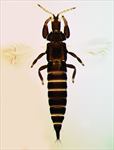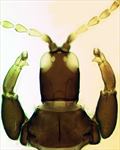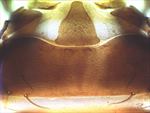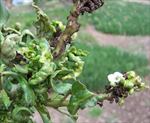
Male

Male head & pronotum (holotype)

Pelta & tergite II

Segments IX–X (tube)[male]

Fore wing

Leaf distortion by Klambothrips on Myoporum in California
Both sexes fully winged and variable in body size. Body and legs dark brown with tarsi yellow, antennal segments III–VI and sometimes base of VII yellow. Antennae 8-segmented, III with one sense cone, IV with 3 sense cones, VIII broad at base. Head longer than wide; cheeks with one pair of stout setae in basal third; maxillary stylets retracted at least to postocular setae; postocular setae no larger than minor setae. Pronotum with three pairs of capitate major setae, anteromarginals and midlaterals usually no larger than discals. Prosternal basantra not developed; mesopresternum reduced to two small lateral triangles. Fore tarsus with inner apex slightly recurved forming a small tooth in female; large male with fore tarsal tooth massive and femora swollen. Fore wing parallel sided, with 6–9 duplicated cilia; with one or two capitate sub-basal setae. Pelta triangular, reticulate, with paired campaniform sensilla; tergites II–VII with two pairs of sigmoid wing-retaining setae; tergite IX setae S1 and S2 shorter than tube, bluntly pointed to weakly capitate, S3 acute; anal setae long.
Male similar to female; sternite VIII without pore plate; large males have much larger fore legs than small males.
The genus Klambothrips includes five described species from Australia, three causing leaf distortion on Myoporaceae species and two causing similar damage on Asteraceae species (Mound & Morris, 2007).
Larvae, pupae and adults associated with severe distortion of young terminal leaves, and sometimes stunting growth of Myoporum laetum, and Myoporum sandwichense [Myoporaceae].
Originally from southeast Australia and Tasmania, but introduced to USA in California and Hawaii (Cameron & Mound, 2014).
PHLAEOTHRIPIDAE, PHLAEOTHRIPINAE
Klambothrips myopori Mound & Morris, 2007: 35-45
Cameron SL & Mound LA (2014) Trans-Bass Strait speciation and trans-Pacific dispersal in the Myoporum thrips (Thysanoptera, Phlaeothripinae). Austral Entomology 53: 36–41.
Mound LA & Morris DC (2007) A new thrips pest of Myoporum cultivars in California, in a new genus of leaf-galling Australian Phlaeothripidae (Thysanoptera). Zootaxa 1495: 35–45.